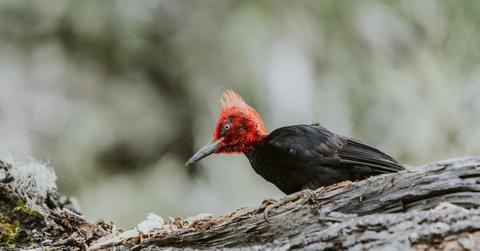Ivory-Billed Woodpecker Is One of 22 Animals Declared Extinct in the U.S. Today
Published Sept. 29 2021, 1:02 p.m. ET

A Magellanic Woodpecker, part of the genus Campephilus, which the ivory-billed woodpecker was also part of.
So long, Woody.
Well, Woody Woodpecker was technically inspired by a pileated woodpecker, a species that is still doing OK. But this morning, the ivory-billed woodpecker was declared extinct. And he’s not the only one — the U.S. government just bestowed the dreaded extinct designation upon a total of 22 animal species and one plant species, all of which were previously protected by the Endangered Species Act.
Keep reading for the full list of newly-extinct creatures, and for a look at how the climate crisis is related to extinction.
The ivory-billed woodpecker has been unobserved for decades, and is now extinct.
While all 23 extinctions are significant losses, the most famous of the group of now-extinct species is the ivory-billed woodpecker, as reported by AP News. Native to Arkansas, the ivory-billed woodpecker was last spotted in Louisiana in 1944, and has been protected by the ESA and its precursor, the Endangered Species Preservation Act, since 1967, as per the USFWS.
These 22 animal species are now extinct.
On Sept. 29, 2021, the U.S. Fish and Wildlife Service (USFWS) announced proposals to delist 23 different species from the Endangered Species Act. Being delisted from the ESA is sometimes a positive thing, as it can mean that a species has made a miraculous comeback and no longer needs protection; however, in this case, it’s the opposite. All 23 species have been declared extinct.
Of the 23 species, 11 are birds, most of which were native to Hawaii:
- Bachman’s warbler
- Bridled white-eye
- Ivory-billed woodpecker
- Kauai akialoa,
- Kauai nukupuu
- Kauaʻi ʻōʻō
- Large Kauai thrush
- Maui ākepa
- Maui nukupuʻu
- Molokai creeper
- Po`ouli
Eight are mussels:
- Flat pigtoe mussel
- Green-blossom pearly mussel
- Southern acornshell mussel
- Tubercled-blossom pearly mussel
- Turgid-blossom pearly mussel
- Upland combshell mussel
- Yellow-blossom pearly mussel
- Stirrupshell mussel
Two are fish species:
- San Marcos gambusia
- Scioto madtom
One bat species was just declared extinct: the Little Mariana fruit bat, which was last officially seen in Guam in 1968.
And the final species to be declared extinct is a Hawaiian plant species: Phyllostegia glabra var. Lanaiensis, which hasn’t been seen for more than a century.
Climate change contributes to species extinction.
Deforestation, animal agriculture, and digging for fossil fuels are just a few of the things that Earth’s most powerful industries are doing on mass scales every day that are not only fueling the climate crisis, but also leading to species extinctions. That's because these mass-scale activities cause habitat loss, introduce invasive species, changes in weather and precipitation, and much more, all of which can cause extinction, as noted by The Royal Society.
Interior Secretary Deb Haaland agrees that these 23 particular extinctions are connected to the climate crisis.
“With climate change and natural area loss pushing more and more species to the brink, now is the time to lift up proactive, collaborative, and innovative efforts to save America's wildlife. The Endangered Species Act has been incredibly effective at preventing species from going extinct and has also inspired action to conserve at-risk species and their habitat before they need to be listed as endangered or threatened,” Haaland said in a statement.
“We will continue to ensure that states, Tribes, private landowners, and federal agencies have the tools they need to conserve America’s biodiversity and natural heritage,” she added.
The USFWS says that it has worked tirelessly to recover the ivory-billed woodpecker and all the other species delisted today, but sadly, the government agency has officially retired these searches. Hopefully the time and energy that would have been spent looking for these 23 species will be put to a new, positive use, since many other species are in need of protection.